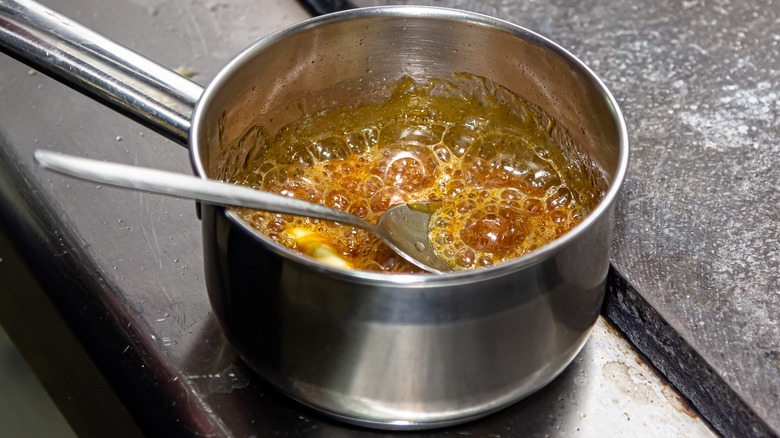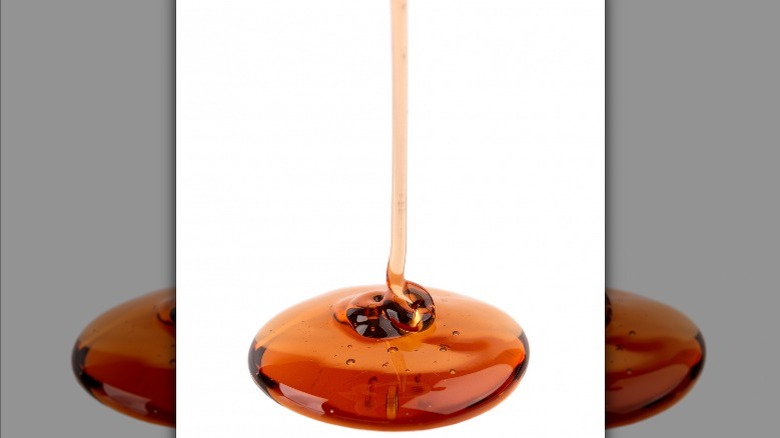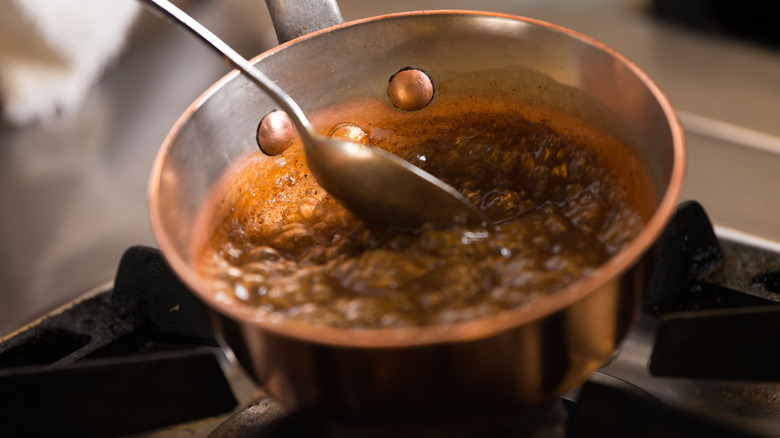Burnt Sugar Is Much More Delicious Than It Sounds
Initially, burnt sugar doesn't sound all that tasty, but don't worry: It's a misnomer. The ominous-sounding ingredient is really a type of caramel cooked to a rich, deep brown, treacly consistency, but it isn't actually burned. As a result, if done correctly, the subsequent caramelized syrup can be quite a delicious addition to various sweet treats and even dishes with other flavor profiles.
For instance, burnt sugar is often utilized in Caribbean cuisine, and it's essential to many foods enjoyed around the region, such as Trinbagonian pelau. Including this syrup in savory dishes adds an extra kick of sweetness similar to molasses plus a touch of darkened color to sauces and the like. However, the sweet sauce's uses go beyond just that, and it can be incorporated into desserts like Christmas black cake and almost anything that calls for caramel. Still, it's only fair to explain that caramelized sugar is cooked at a different temperature.
What's the difference between caramel and burnt sugar?
It's pretty straightforward to caramelize sugar in terms of ingredients and directions. However, that doesn't mean some dedicated attention isn't necessary. Depending on the type of caramel, the sauce will cook at various temperatures as the sugar melts, and this is known to be quite finicky; it isn't one of those cooking procedures that can easily be stepped away from once you start, because things can burn rather quickly. However, burnt sugar differs from other types of caramels due to the amount of heat needed to get the right consistency, color, and taste.
Before discussing temperature ranges, the concept of caramelization should be considered. In short, caramelization occurs when sugar is oxidized and broken down via the application of heat. As the syrup beings to cook, it gradually darkens into that familiar golden-brown color everyone expects from caramel. Still, it'll become even darker if exposed to too much heat. Hence, a candy thermometer can prove handy for anticipating doneness.
Typically, a regular caramel sauce is heated at around 340 to 360 degrees Fahrenheit, depending on whether the goal is to create a light or medium caramel. However, burnt sugar must be taken nearer to 380 degrees Fahrenheit. Nevertheless, you want to avoid the temperature going too high, because the sugar will break down into carbon and become unusable, then there's no salvaging it. This may take some practice, because burnt sugar has a tinge of bitterness yet it can quickly become too sharp and inedible if scorched.
Other things to consider when making burnt sugar
Granted, working with sugar can be stressful and, if you're not careful, outright dangerous — sugar burns are no joke. With that in mind, one should take some precautions when making burnt sugar. After all, as anyone who's ever experienced a burn of this nature can tell you, it's an event that sticks with you long after the pain is gone.
So, you'll want to get a large enough pot to avoid any chance of splashback escaping. Additionally, hot sugar syrup will bubble up and splatter when things like water are introduced, and depending on the recipe, adding water may be a necessary step. Still, some workarounds, like reducing the cooking heat to slow down the overall process or (perhaps counterintuitively) adding hot water instead of cold, will help diminish the likelihood of the sauce flaring up.
Another thing to consider is which type of sugar is being used. While white sugar can be employed, certain recipes call for other types of sugar. Either way, just be patient with the process and remember: A wrecked sauce can always be thrown out before starting over, especially since the ingredients needed are relatively cheap and common.


